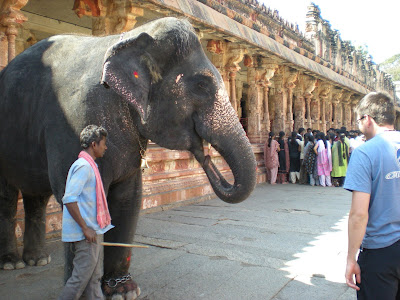Five hundred years ago, Vijayanagar was a major power in South Asia. The city ruled most of southern India and became the center of Hindu civilization after the bulk of northern India became dominated by Islam. In 1565, Vijayanagar was defeated and sacked by enemy troops. The city was abandoned, and every wood and mud building was left to rot.

What remains are the ruins of stone temples, strewn over several square kilometers of rocky plain. The nearby village of Hampi caters to the many tourists who visit. (Seriously - Hampi's economy seems to be entirely tourism-based.)
Although Hampi consists mostly of guesthouses and shops catering to tourists, it also contains Virupaksha Temple, which is of some interest.

 Those are cattle in front of the temple entrance. My first authentic Indian wandering cattle.
Those are cattle in front of the temple entrance. My first authentic Indian wandering cattle. A macaque hanging out at the temple. In the late afternoon, monkeys become very active in Hampi, foraging for food and comically falling out of trees.
A macaque hanging out at the temple. In the late afternoon, monkeys become very active in Hampi, foraging for food and comically falling out of trees. That's the temple elephant. If you put a rupee in her trunk, she blesses you by thwunking you on the head. I gave her a banana. She gulped it down and then began sniffing my bag (which had more bananas). I quickly made distance between her and me before she could investigate further.
That's the temple elephant. If you put a rupee in her trunk, she blesses you by thwunking you on the head. I gave her a banana. She gulped it down and then began sniffing my bag (which had more bananas). I quickly made distance between her and me before she could investigate further.Once you leave the town of Hampi proper, you find yourself in an arid, rocky landscape full of temples and rocky ruins.



 You cannot see everything there is to see in one day. You can spend several days wandering the area to take it all in.
You cannot see everything there is to see in one day. You can spend several days wandering the area to take it all in.

On our last day in Hampi, we crossed the Tungabhadra River by coracle to see the Hanuman Temple on the north bank. The temple is located on top of a large hill; you have to climb about 500 steps to reach the top. Once you reach the summit, you find some spectacular views to share with the handful of other backpackers who also made the climb.
 Afterwards we re-crossed the river by coracle near the town of Anegundi. The two of us shared the tiny coracle with three men and their motorbikes. It did not appear to be a terribly safe situation at first but we (somehow!) crossed the river without sinking.
Afterwards we re-crossed the river by coracle near the town of Anegundi. The two of us shared the tiny coracle with three men and their motorbikes. It did not appear to be a terribly safe situation at first but we (somehow!) crossed the river without sinking.We crossed just adjacent to a bridge, under construction, that was to span the river (and possibly put the coracle operators out of business!).
Later that day, as we were preparing to leave the Hampi area, we heard of a bridge collapse in the area. We figured it probably wasn't the unfinished bridge we saw (the time frame seemed too restricted), but this story in The Hindu seems to confirm that it was, indeed, that same bridge. It must have happened minutes after we left the scene.
We were never in danger; we would not have been hurt even if we'd witnessed the collapse. But we were so close to it.
1 comment:
Thanks for a great description on Hampi
Regards
Hampi Tourism
Post a Comment